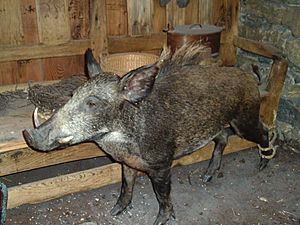Grice facts for kids

A reconstruction of a grice
|
|
| Conservation status | Extinct |
|---|---|
| Other names |
|
| Country of origin | Scotland |
| Traits | |
|
|
The grice was a type of pig that used to live in the Highlands and Islands of Scotland and in Ireland. Sadly, it is now extinct. It lasted longest in the Shetland Isles, disappearing completely between the mid-1800s and the 1930s. People also called it the Highland, Hebridean, or Irish pig.
Contents
What's in a Name?
The word "grice" comes from an old Scottish and northern English word. It originally meant "young pig." You can find a similar word, gris, meaning "pig," in Scandinavian languages today.
A Look at the Grice
Stories from the early 1800s tell us what the grice was like. It was a tough animal, often described as aggressive. It had small tusks and a back that curved upwards. Its body was covered in stiff, dark bristles, with a woolly fleece underneath.
Grice from the Scottish Highlands were described as small and thin. Their bristles stood up from their nose all the way to their tail. Like other animals in these areas, the grice was small and very hardy. This meant it could survive the harsh weather and tough conditions. Highland grice would search for berries on the moorland to eat.
How People Used the Grice
Most crofts (small farms) in Shetland would have at least one grice. These pigs would often roam freely on grazing lands. Sometimes, they would wander onto nearby farms. There, they might dig up crops or even kill and eat newborn lambs.
According to Samuel Hibbert, who wrote about the islands in 1822, the grice was "small and scrawny." However, its meat made "excellent hams" when cured. Islanders also found other uses for the grice. They made footballs from the pig's bladder. They even used its intestines to make windowpanes! They would stretch the membrane over a wooden frame until it was thin enough to let light pass through. The animal's stiff bristles were used as thread for sewing leather and for making ropes.
Even though these animals were useful, neighbors often complained about the grice's behavior. The local courts could take away pigs that caused too much trouble. Owners of these pigs could also face "hefty fines."
Why the Grice Disappeared
In the 1800s, landowners started to discourage people from keeping these pigs. One writer about farming said the grice ate a lot and was hard to keep in one place. They also said it was "destructive and mischievous." Because of this, they thought the grice should slowly be removed.
This idea, along with more pigs being brought in from the Scottish mainland, led to fewer and fewer grice. Sometime between the mid-1800s and the 1930s, the grice breed became extinct.
Even though the grice is gone, its memory lives on. A wild flower called spring squill is known locally as "grice's onions." This is because it was a favorite food of the grice.
Bringing the Grice Back to Life
In 2006, the Shetland Museum and Archives asked a taxidermist to create a model of a grice. They used the stuffed body of a young wild boar to do this. Since no one alive had ever seen a grice, the model's accuracy relied on old descriptions and archaeological findings. The model grice was put on public display in the spring of 2007.
In 2020, a skull was found in Nesting. This might be the first complete grice skull ever recorded. Some people have doubts about the skull's origin because its snout is shorter than expected. However, 2020|August|lc=y, experts are still working to confirm if it is truly a grice skull.

